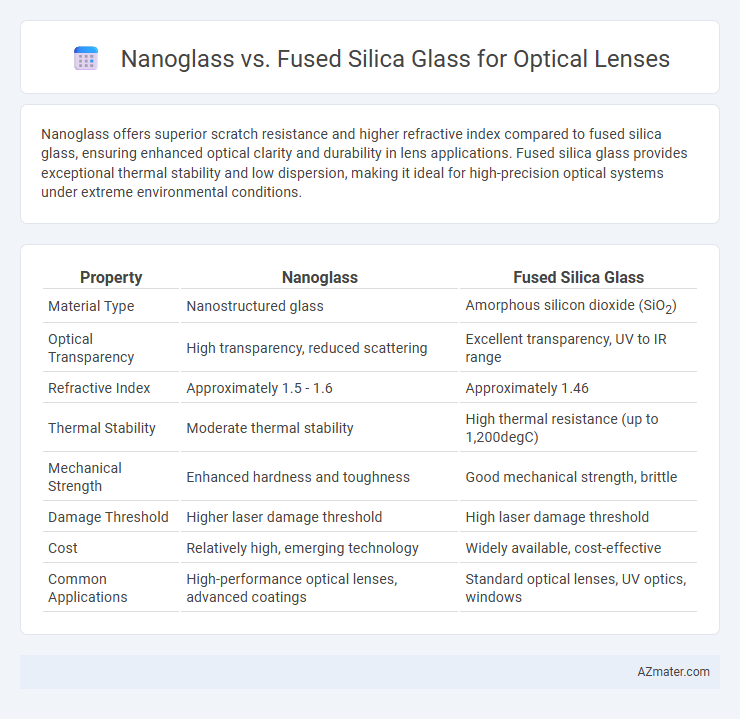Nanoglass offers superior scratch resistance and higher refractive index compared to fused silica glass, ensuring enhanced optical clarity and durability in lens applications. Fused silica glass provides exceptional thermal stability and low dispersion, making it ideal for high-precision optical systems under extreme environmental conditions.
Table of Comparison
| Property | Nanoglass | Fused Silica Glass |
|---|---|---|
| Material Type | Nanostructured glass | Amorphous silicon dioxide (SiO2) |
| Optical Transparency | High transparency, reduced scattering | Excellent transparency, UV to IR range |
| Refractive Index | Approximately 1.5 - 1.6 | Approximately 1.46 |
| Thermal Stability | Moderate thermal stability | High thermal resistance (up to 1,200degC) |
| Mechanical Strength | Enhanced hardness and toughness | Good mechanical strength, brittle |
| Damage Threshold | Higher laser damage threshold | High laser damage threshold |
| Cost | Relatively high, emerging technology | Widely available, cost-effective |
| Common Applications | High-performance optical lenses, advanced coatings | Standard optical lenses, UV optics, windows |
Introduction to Optical Lens Materials
Nanoglass offers enhanced optical clarity and higher refractive indices compared to fused silica glass, making it ideal for precision optical lenses. Fused silica glass is renowned for its excellent thermal stability, low thermal expansion, and superior UV transparency, widely used in demanding optical applications. Key differences lie in nanoglass's improved mechanical strength and tailored optical properties versus fused silica's robust durability and chemical resistance.
Overview of Nanoglass
Nanoglass offers a revolutionary alternative to fused silica glass in optical lenses by providing enhanced mechanical strength and improved thermal stability through its nanoscale structure. Its unique composition reduces scattering and increases transparency, resulting in higher optical clarity and precision in lens performance. This advanced material enables the development of lighter, more durable lenses with superior resistance to environmental factors compared to traditional fused silica glass.
Overview of Fused Silica Glass
Fused silica glass, made from high-purity silicon dioxide, offers exceptional optical transparency across ultraviolet to infrared wavelengths and superior thermal stability compared to standard glasses. Its low thermal expansion coefficient and high resistance to thermal shock make it ideal for precision optical lenses used in high-performance environments. The material's inherent chemical durability and low birefringence further enhance its suitability for advanced optical applications.
Optical Properties: Nanoglass vs Fused Silica
Nanoglass exhibits superior optical properties compared to fused silica glass, including higher refractive indices and enhanced light transmission across ultraviolet to near-infrared wavelengths. Its nanoscale structure reduces scattering, resulting in improved clarity and resolution for high-precision optical lenses. Fused silica glass, while offering excellent thermal stability and low thermal expansion, typically shows lower refractive index and slightly higher optical loss relative to nanoglass materials.
Mechanical Strength and Durability
Nanoglass exhibits superior mechanical strength compared to fused silica glass, making it more resistant to scratches and impacts, which enhances the durability of optical lenses in demanding environments. The nanostructured grains in nanoglass reduce crack propagation, significantly improving fracture toughness relative to the amorphous structure of fused silica. Fused silica, while renowned for its thermal stability and optical clarity, often falls short in mechanical endurance under physical stress compared to the reinforced nanoglass composite.
Thermal Stability and Resistance
Nanoglass exhibits superior thermal stability compared to fused silica glass, maintaining its structural integrity and optical properties under higher temperature fluctuations. Its enhanced resistance to thermal shock and deformation makes nanoglass ideal for precision optical lenses in environments with rapid temperature changes. Fused silica glass, while also known for excellent thermal resistance, is slightly less resilient to extreme thermal cycling, making nanoglass a preferred choice in high-performance optical applications requiring consistent thermal durability.
Transmission and Clarity Comparison
Nanoglass lenses exhibit superior transmission rates, often exceeding 98%, due to their ultra-smooth surface and minimized scattering, significantly enhancing optical clarity in precision applications. Fused silica glass provides excellent UV to infrared transmission, typically around 92-95%, but may suffer from slightly higher surface roughness, leading to marginally reduced clarity in high-resolution imaging. The choice between nanoglass and fused silica depends on the required balance of maximum light throughput and cost-efficiency in optical lens manufacturing.
Cost-Effectiveness and Availability
Nanoglass offers superior optical clarity and enhanced durability compared to fused silica glass, which often comes at a higher production cost due to complex manufacturing processes. Fused silica glass, while more expensive, boasts excellent thermal stability and is widely preferred for high-precision optical lenses in scientific applications. Cost-effectiveness leans toward nanoglass for consumer-grade optics due to lower material and fabrication expenses, whereas fused silica remains the standard in advanced optics requiring maximum performance and availability from specialized suppliers.
Applications in Optics and Photonics
Nanoglass exhibits superior mechanical strength and higher laser damage thresholds compared to fused silica glass, making it ideal for high-power laser optics and precision photonics applications. Its enhanced thermal stability and reduced optical scattering improve performance in UV lithography, optical sensors, and nonlinear optical devices. Fused silica glass remains preferred for its exceptional chemical durability and wide transmission range, suited for standard lenses, fiber optics, and UV to IR spectroscopy.
Choosing the Right Material for Your Optical Lens
Nanoglass offers superior light transmission and enhanced scratch resistance compared to fused silica glass, making it ideal for high-precision optical lenses used in advanced imaging systems. Fused silica glass excels in thermal stability and low thermal expansion, which is critical for lenses in high-temperature environments or laser applications requiring minimal distortion. Selecting the right material depends on balancing optical clarity, durability, and environmental conditions specific to your lens application.

Infographic: Nanoglass vs Fused silica glass for Optical lens
 azmater.com
azmater.com